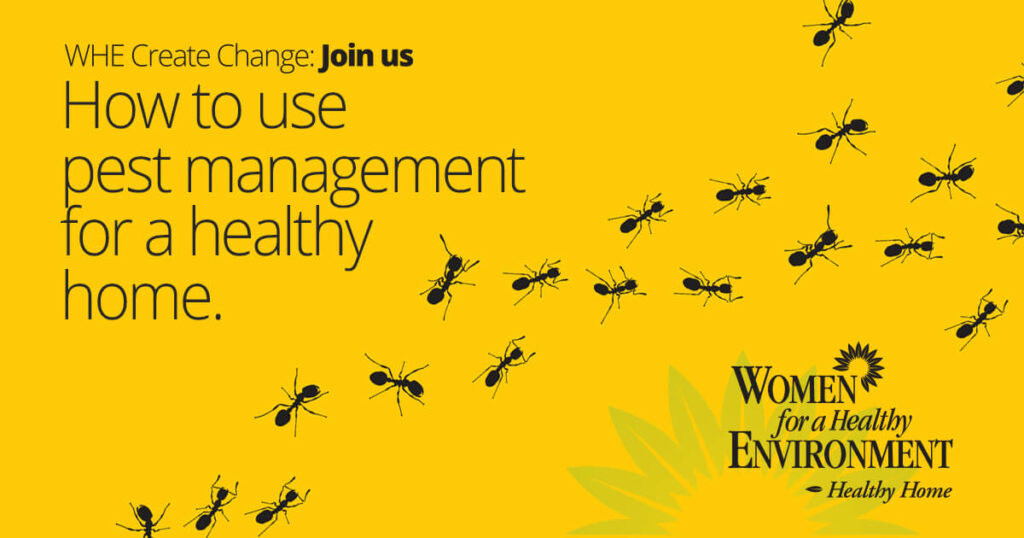As we approach warmer days, WHE wanted to share some resources on how to safely and effectively deal with pests both in the home and garden.
Unfortunately, at some point we have likely encountered (or inevitably will have to deal with) unwanted critters in their home. The droppings or body parts of cockroaches and other pests such as mice can trigger asthma and/or allergic reactions. Before we make a trip to the local hardware store, there are safer and more effective ways to deal with pests than using chemicals.
Insecticides and pesticides are not only toxic to pests — they can harm people, too. We are typically exposed to pesticides through multiple pathways, including:
- Oral: Food, water, toys/fingers/other objects put in mouth
- Dermal: Anything that comes in contact with and is absorbed through their skin
- Respiratory: The air we breathe
- Pre-natal: One study tracked 316 urban minority women and found all had detectable levels of 3 insecticides, indicating that pesticides had been transferred from mother to fetus during pregnancy.
According to the Pesticide Action Network, pesticides are toxic, and exposure to pesticides can cause a number of health effects. They are linked to a range of serious illnesses and diseases from respiratory problems to cancer. Pesticides can be acutely toxic. This means that they can cause harmful or lethal effects after a single episode of ingestion, inhalation or skin contact. Pesticides can also have chronic toxicity and cause harmful effects over an extended period, usually following repeated or continuous exposure at low levels. Low doses don’t always cause immediate effects, but over time, they can cause very serious illnesses.
According to Beyond Pesticides, of the 30 most commonly used lawn pesticides, 17 are possible and/or known carcinogens, 18 have the potential to disrupt the endocrine (hormonal) system, 19 are linked to reproductive effects and sexual dysfunction, 11 have been linked to birth defects, 14 are neurotoxic, 24 can cause kidney or liver damage, and 25 are sensitizers and/or irritants. Of those same 30 lawn pesticides, 19 are detected in groundwater, 20 have the ability to leach into drinking water sources, 30 are toxic to fish and other aquatic organisms vital to our ecosystem, 29 are toxic to bees, 14 are toxic to mammals, and 22 are toxic to birds. Additionally, children are more at risk from pesticides because they have higher exposure rates than adults and are more vulnerable to their effects.
What are the best practices and healthier alternatives to dealing with pests? Integrated Pest Management (IPM) is a stepwise approach to pest management that combines accurate knowledge of the pest and level of potential harm with multiple tactics to prevent, reduce or eliminate pests. The emphasis is on using non-chemical means to address pest problems first, with an emphasis on preventing pest conducive conditions. Some pest management methods pose less of a risk and are easy to follow. Here are some tips for dealing with pests in your home:
- Keep counters, sinks, tables and floors clean and free of clutter.
- Clean up dishes, crumbs and spills right away.
- Store food in airtight containers.
- Seal cracks or openings around cabinets and the home’s foundation.
- Use physical controls like sticky traps for insects and snap traps for rodents.
Additionally, here are some best practices for minimizing pests in a yard/garden provided from the PA DEP:
- Grow pest resistant plants, shrubs, and trees.
- Avoid hurting tree trunks with mowers and weed whackers.
- Put mulch at tree bases.
- Keep an adequately fertilized lawn.
- Hand dig and spot treat weeds.
- Pay attention to organic matter, watering, and other conditions for healthy plants.
- Do not grow the same types of plants (e.g. tomatoes, peppers, eggplant) in the same place each year.
- Grow composite flowers for the good insects to land and feed on (such as Queen Anne’s lace, daisies, fennel, dill).
- Do not mow the grass to less than 3 inches
If you want to learn more or have any questions, please email hanna@womenforahealthyenvironment.org to get connected!
Additional Resources
EPA Citizen’s Guide to Pest Safety https://www.epa.gov/sites/production/files/2017-08/documents/citizens_guide_to_pest_control_and_pesticide_safety.pdf
EPA Lawn and Garden https://www.epa.gov/safepestcontrol/lawn-and-garden#pratices
PA IPM Program https://extension.psu.edu/ipm
Beyond Pesticides https://www.beyondpesticides.org/resources/managesafe/overview
Pesticide Action Network http://www.panna.org/resource-library
Pesticide Info database https://www.pesticideinfo.org/





